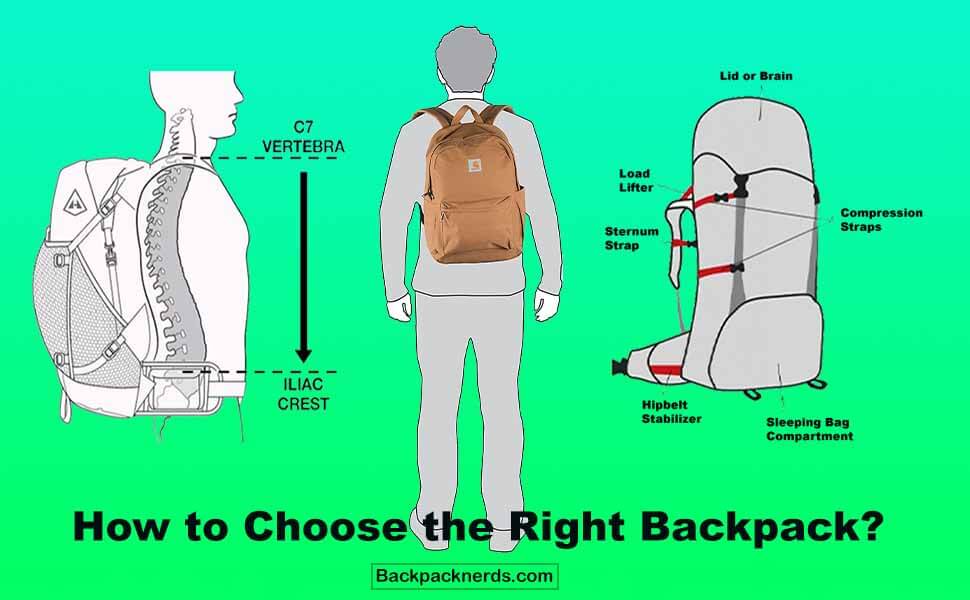Choosing the right backpack is an important decision, whether you’re a student, a traveler, a hiker, or someone who needs to carry their essentials and travel gadgets on a daily basis. With so many different styles, sizes, and features available, it can be overwhelming to decide which backpack will suit your needs best. A poorly chosen backpack can not only lead to discomfort and inconvenience but also pose a risk to your health by causing strain or injury to your back and shoulders. That’s why by knowing how to choose the right backpack, you can make the best decision. In this guide, we’ll explore the key factors to consider when choosing a backpack, to help you make an informed decision and find the perfect backpack for your needs.
You can know more from our backpack size guide.
How to Choose the Right Backpack?

What would you check if you would go to buy a backpack for hiking or a backpacking pack? If you are a new backpacker and don’t have enough experience with it, well, there are primarily 3 considerable factors that you need to be concerned with. They are:
- Backpack capacity
- Backpack features
- Backpack fit
Let’s know a little bit about the factors now. You can have a clear idea if you know it.
- Backpack capacity: The capacity of a backpack refers to the size of the backpack and how much it can hold. Know how to choose the right backpacking backpack and you will know the backpack capacity as well. You’ll need to consider how much gear you’ll be carrying and choose a backpack with a capacity that fits your needs. Backpack capacity is usually measured in liters.
- Backpack features: Backpacks come with a variety of features such as pockets, straps, and attachments. You’ll need to consider which features are important to you based on your intended use. For example, if you plan to use your backpack for hiking, you may want a backpack with a hydration system and trekking pole attachments.
- Backpack fit: This refers to how well the backpack fits your body. A backpack that doesn’t fit properly can cause discomfort and even injury. You’ll need to consider factors such as your torso length, hip size, and shoulder width when choosing a backpack that fits well. It’s important to try on a backpack and adjust the straps to ensure a comfortable fit before making a purchase.
Related Articles:
- How to Wear a Backpack Properly
- How to Fit Your Backpack Properly
- Backpack Size Guide
- Effective Tips for Preventing Back Pain from Wearing a Backpack
Types of Backpacks (Size and Capacity)
There are many different types of backpacks, each designed for a specific purpose or activity. Here are some of the most common types of backpacks:
- Daypacks: Daypacks are small backpacks designed for carrying essentials for a day trip or hike.
- School Backpacks: The School backpacks are designed for students to carry books, laptops, and other school supplies.
- Laptop Backpacks: These Laptop backpacks have padded compartments specifically designed to hold laptops and other electronic devices.
- Travel Backpacks: These backpacks for travel are designed for travelers, with features like multiple compartments, padded straps, and easy-access pockets.
- Hiking Backpacks: Hiking backpacks are designed for hiking and camping trips, with features like hydration systems, gear loops, and compression straps.
- Cycling Backpacks: Cycling backpacks are made for cyclists, with features like waterproof fabrics, reflective strips, and helmet attachments.
- Running Backpacks: The running backpacks are designed for runners, with features like lightweight fabrics, hydration systems, and breathable mesh.
- Tactical Backpacks: Tactical backpacks are specially designed for military and law enforcement personnel, with features like MOLLE webbing, reinforced stitching, and rugged materials.
- Fashion Backpacks: The fashion backpacks are designed for style and fashion, with a focus on trendy designs and materials.
- Camera Backpacks: These camera backpacks are designed for photographers, with padded compartments for cameras, lenses, and other photography equipment.
Now we will discuss the type of backpacks that are categorized based on capacity. And these types of backpacks are most common for hiking, camping, and multi-day traveling.
Types of Backpacks Based on Capacity
Backpacks are also categorized by their capacity, which is measured in liters. Here are some of the most common types of backpacks based on capacity:
- Daypacks (less than 20 liters): Daypack backpacks are designed for carrying essentials for a day trip or hike.
- Overnight Backpacks (20-35 liters): These backpacks are designed for short overnight trips and can hold enough gear for a night or two.
- Weekend Backpacks (35-50 liters): Weekend backpacks are designed for weekend trips and can hold enough gear for a few nights.
- Multi-Day Backpacks (50-80 liters): Multi-day backpacks are designed for longer trips, such as backpacking, camping, or mountaineering, and can hold several days’ worth of gear.
- Expedition Backpacks (80+ liters): Expedition backpacks are designed for extended trips, such as expeditions, and can hold large amounts of gear, food, and supplies. They are often used for mountaineering, trekking, or other backcountry activities where you need to carry everything with you.
Though we know about these backpacks already, we will now learn about some backpacks that are used for multi-day use. Those backpacks are frequently used for hiking, trekking, traveling, and other activities.
Backpack Types for Multi-days Use
When you are going hiking for multi-days or extended trips, one of your best companions is your backpack. You can pack all your necessary items and your guide to choosing the best travel backpack can help you out of this crisis. Now let’s find those hiking backpacks.
- Weekend (1-3 nights; 30-50 liters)
- Multiday (3-5 nights; 50-80 liters)
- Extended-trip (5+ nights; 70 liters or larger)
Weekend Backpacks (1-3 nights; 30-50 liters)
Weekend backpacks are designed for trips lasting 1-3 nights and typically have a capacity of 30-50 liters. They are ideal for people who want to travel light and only need to bring a few essential items. These backpacks usually have enough space to carry clothing, toiletries, and small camping gear like a tent and sleeping bag. They are also suitable for day hikes and other outdoor activities. Weekend backpacks are often lightweight and comfortable, with features like padded straps, back panels, and hip belts to distribute the weight evenly. They come in a variety of styles and materials, including backpacking-specific models and urban designs for city breaks.
Multiday Backpacks (3-5 nights; 50-80 liters)
Now, it comes to the multi-day backpacks that are specially designed for trips lasting 3-5 nights and have a capacity of 50-80 liters. These backpacks are larger and more spacious than weekend backpacks, with enough room to hold a tent, sleeping bag, cooking gear, and other essentials. They are ideal for backpackers, hikers, and mountaineers who need to carry all their gear with them on extended trips. Multi-day backpacks often have features like hydration systems, multiple compartments, and compression straps to help organize and secure the load. They are also designed to be comfortable for long periods, with adjustable straps, padded hip belts, and breathable back panels. These types of backpacks come in a range of styles and materials, from ultralight backpacking models to more rugged, durable designs for backcountry expeditions.
Extended-trip Backpacks (5+ nights; 70 liters or larger)
The extended-trip backpacks are simply great for trips lasting 5 or more nights and typically have a capacity of 70 liters or larger. These backpacks are the largest and most spacious type of backpack, capable of holding all the gear, food, and supplies needed for extended expeditions. They are commonly used by serious backpackers, mountaineers, and expedition teams who need to carry everything with them for extended periods. Extended-trip backpacks often have features like detachable lids, multiple pockets, and compression straps to help organize and secure the load. They are also designed for comfort and durability, with adjustable suspension systems, reinforced frames, and padded hip belts. Extended-trip backpacks are usually made of high-quality materials that can withstand extreme weather conditions and rugged terrain. These backpacks are a significant investment and are recommended for experienced backpackers or those planning extended backcountry trips.
Backpack Features
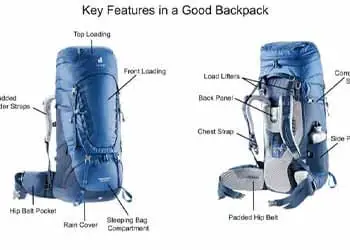
How to choose the right backpack size or how to select the right backpack? What should be the features? Well, a good backpack should not only be durable and spacious but also comfortable to wear and equipped with useful features. Backpack features can make a significant difference in the comfort and functionality of a backpack, from the straps to the pockets and compartments.
We will divide the backpack features into two types:
- Must-Have Features
- Additional Features
Let’s now discuss the features one by one. And then you will have a better idea about good backpacks.
Must-Have Features in a Good Backpack
Backpack Frames
Backpack frames come in different types, each designed for specific purposes and activities. Here are some of the most common types of backpack frames:
- Internal frame: These frames are designed to sit close to your back and provide a more stable and comfortable fit. They are ideal for backpackers and hikers who carry heavy loads and need good support and balance.
- External frame: The external frames are designed to keep the backpack away from your back and allow for more ventilation. They are ideal for carrying large or bulky loads and are commonly used for hunting, camping, and other outdoor activities.
- Frameless: These backpacks do not have a rigid frame and rely on the shape of the pack and the load to provide support. They are ideal for lightweight backpacking and day hikes.
- Hybrid: These frames combine the best of both worlds, with an internal frame for stability and an external frame for extra support and ventilation. They are ideal for backpackers who need a versatile and adaptable backpack for various activities.
- Airframe: The Airframes use inflatable chambers to provide support and ventilation. They are ideal for ultralight backpacking and day hikes and can be easily deflated for compact storage.
- Crossover frame: These frames are designed to be used as both internal and external frames, depending on the activity and load. They are ideal for backpackers who need a versatile backpack that can adapt to different situations.
Ventilation System
Many modern backpacks come with a ventilation system that helps to keep you cool and comfortable during long hikes or extended use. Here are some of the most common types of ventilation systems:
- Back panel ventilation: This system uses mesh and foam panels to create space between your back and the backpack, allowing air to circulate and cool your back.
- Shoulder strap ventilation: The shoulder strap ventilation system uses mesh and foam panels in the shoulder straps to create air channels that increase airflow and reduce sweat buildup.
- Hip belt ventilation: This system uses mesh and foam panels in the hip belt to increase ventilation and reduce pressure on the hips.
- Suspended mesh: The suspended mesh system suspends the backpack away from your back using a mesh panel, creating a large air gap that allows for maximum ventilation.
- Frame ventilation: This type of ventilation system uses an external frame with a mesh or perforated design that allows air to circulate and cool your back.
- Hydration system ventilation: This system uses a hydration bladder with an insulated sleeve and ventilation channel to keep your water cool and prevent condensation from building up inside the backpack.
Ventilation systems are especially important for backpackers who plan to hike in hot and humid environments or who will be carrying heavy loads for extended periods. They can help to prevent heat exhaustion, reduce fatigue, and make your backpacking experience more enjoyable.
Pack Access
Pack access refers to how you can access the contents of your backpack. There are three main types of pack access:
- Top-loading: This is the most common type of pack access, where you access the main compartment of the backpack through a drawstring closure at the top of the pack. This type of access is simple and reliable and allows for easy packing and unpacking.
- Front-loading: This type of pack access allows you to access the main compartment of the backpack through a zipper on the front of the pack. This type of access is useful for organizing and accessing your gear quickly and easily.
- Panel-loading: This type of pack access allows you to access the main compartment of the backpack through a zipper that runs around the side of the pack. This type of access is useful for accessing gear that is packed in the middle of the backpack without having to remove everything else.
The type of pack access you choose depends on your personal preference and the type of activity you will be doing. Top-loading packs are generally lighter and more durable, while front-loading and panel-loading packs are more versatile and easier to organize. Some backpacks combine different types of access for added convenience and flexibility.
Pockets of the Backpacks
Backpacks come with various pockets that are designed to help you organize and store your gear. So how do you choose the right backpack? Do you care for backpack pockets? Well, here are some of the most common types of backpack pockets:
- Main compartment: This is the largest compartment of the backpack and is used to store your bulky gear and clothing.
- Front pocket: This is a smaller pocket located on the front of the backpack and is ideal for storing smaller items that you need to access quickly, such as snacks, maps, or sunglasses.
- Side pockets: These pockets are located on the sides of the backpack and are ideal for storing water bottles or other items that you need to access quickly.
- Hip belt pockets: These small pockets are located on the hip belt and are ideal for storing small items that you need to access quickly, such as a phone or a camera.
- Lid pocket: This pocket is located on the top lid of the backpack and is ideal for storing smaller items that you need to access quickly, such as a headlamp or a first-aid kit.
- Internal pockets: These pockets are located inside the main compartment of the backpack and are ideal for organizing your gear and keeping it easily accessible.
The type and number of pockets in a backpack depend on the backpack’s size, intended use, and design. A backpack with more pockets and compartments may be more organized and easier to use, while a backpack with fewer pockets may be lighter and more streamlined.
Quality / Water-Resistant Materials
There are various water-resistant materials used in backpacks, each with its unique properties and benefits. Here are some of the most commonly used water-resistant materials in backpacks:
- Nylon: Nylon is a popular material for backpacks due to its durability, lightweight, and water resistance. It is often coated with a waterproof layer, making it highly water-resistant.
- Polyester: Polyester is another common material for backpacks, known for its strength and water resistance. It is often treated with a water-resistant coating to keep the contents of the backpack dry.
- Ripstop: Ripstop is a type of nylon that is woven with reinforced threads, making it highly resistant to tears and punctures. It is also water-resistant and often used in backpacks for outdoor activities.
- PVC: PVC, or polyvinyl chloride, is a synthetic plastic material that is highly waterproof and often used as a coating on backpacks. It is a durable material that offers excellent protection against water.
- TPU: TPU, or thermoplastic polyurethane, is a lightweight, flexible, and highly water-resistant material used in backpacks. It is often used in waterproof zippers, liners, and coatings.
These water-resistant materials can be used alone or in combination with each other to create backpacks that are highly water-resistant and ideal for use in wet environments. However, it’s important to note that no backpack is completely waterproof, and additional protection such as a rain cover may be necessary for heavy rain or immersion.
Padding
A backpack with good padding can help increase comfort and reduce fatigue on long hikes. Look for a backpack with padding on the shoulder straps, hip belt, and back panel (we’ll discuss them in later paragraphs). Some backpacks also have additional padding in the lumbar area to provide extra support. The padding should be thick enough to provide cushioning, but not so thick that it adds unnecessary weight to the backpack. Know more about how to choose and fit a backpack.
Padded Hip Belt
A padded hip belt is a supportive belt that is designed to wrap around the waist of a backpack wearer. It is filled with foam padding and has a buckle that helps to distribute weight evenly between the hips and shoulders. This reduces strain on the back and allows for more comfortable carrying.
Padded Shoulder Straps
Padded shoulder straps are designed to provide support and cushioning to the shoulders while carrying a backpack. They are filled with foam padding and can be adjusted to fit the wearer’s size and comfort level. They help to distribute weight evenly and reduce strain on the shoulders and back.
Chest Strap
A chest strap is a strap that goes across the wearer’s chest, connecting the two shoulder straps of a backpack. It helps to keep the backpack stable and prevent it from bouncing or shifting while walking. This strap can also help to distribute weight more evenly and reduce strain on the shoulders and back.
Padded Back Panel
A padded back panel is a feature that is designed to provide cushioning and support to the wearer’s back. It is typically made of foam padding and can be contoured to fit the wearer’s body. This feature helps to reduce pressure points and promote airflow to prevent heat and moisture buildup on the back.
Top and Front Loading
Top and front loading refers to the different ways in which a backpack can be accessed. Top-loading backpacks have a single opening at the top, which allows for easy access to the main compartment. Front-loading backpacks have a zipper or panel that opens up the front of the backpack, providing easy access to all compartments.
Load Lifting Straps
Load lifting straps are adjustable straps that attach to the top of a backpack and can be used to lift and adjust the weight distribution of the load. They help to transfer the weight of the backpack to the shoulders and hips, reducing strain on the back and shoulders. These straps can be adjusted to provide a more comfortable fit and balance the weight of the backpack more evenly.
Sternum Strap
A sternum strap is a vital component of a quality backpack, designed to improve stability, comfort, and weight distribution. This small strap connects the two shoulder straps across the chest, securing the backpack in place and reducing the load on your shoulders. The sternum strap helps stabilize the backpack, keeping it close to your body and reducing movement while you walk, hike, or run. This feature is particularly useful for long hikes or heavy loads, making the sternum strap a valuable addition to any quality backpack.
Additional Features in a Good Backpack
Attachment Points of a backpack
Attachment points on a backpack are strategically located to provide easy access and secure attachment for various items that you may need to carry with you. Here are some common attachment points found on backpacks:
- D-rings: These are small metal rings that are often located on the shoulder straps or other areas of the backpack. They can be used to attach small items like carabiners or keychains.
- Loops: Loops are small fabric or webbing loops that are sewn onto the backpack. They can be used to attach items like water bottles, tent poles, or trekking poles.
- Straps: Many backpacks come with additional straps that can be used to attach larger items like a sleeping bag, sleeping pad, or tent. These straps are often located at the bottom or sides of the backpack.
- Compression straps: Compression straps are used to tighten and compress the backpack to keep the contents secure and stable. They can also be used to attach additional gear to the sides of the backpack.
- MOLLE: MOLLE, or Modular Lightweight Load-carrying Equipment, is a system of attachment points that use webbing and straps to attach various items to the backpack. MOLLE systems are commonly found on military and tactical backpacks.
These attachment points make it easy to customize your backpack and carry additional gear with you, whether you’re hiking, camping, or traveling.
Hydration reservoir
Many backpacks come with a built-in hydration reservoir, which is a water bladder that can be filled with water and then accessed through a tube that runs to the front of the backpack for easy drinking. Look for a backpack with a hydration reservoir that is the right size for your needs and is made of durable materials that won’t leak or puncture easily. The tube should be easy to access and the mouthpiece should be comfortable to drink from.
Rain cover
A rain cover is a waterproof cover that fits over your backpack to protect it from rain and moisture. Look for a rain cover that is the right size for your backpack and is made of high-quality waterproof material. The cover should be easy to put on and take off and should have a snug fit to keep the backpack dry in wet conditions.
Sleeping bag compartment
Many backpacks come with a separate compartment designed specifically for storing your sleeping bag. This is usually located at the bottom of the backpack and can be accessed separately from the main compartment. Look for a sleeping bag compartment that is large enough to accommodate your sleeping bag and has easy access so you can quickly grab your sleeping bag when you need it.
Durability
Choose a backpack made of durable materials that can withstand the rigors of hiking and exposure to the elements. Look for features like reinforced stitching, water-resistant coatings, and abrasion-resistant fabrics.
Weight
Look for a backpack that is lightweight and doesn’t add unnecessary weight to your load. If you know how to pick the right hiking backpack, you must know how much weight the backpack is. However, don’t sacrifice durability and comfort for weight savings.
Fit
Make sure to try on the backpack and adjust the straps to ensure a good fit before making a purchase. A properly fitting backpack can make all the difference in comfort and functionality on the trail.
Price
Consider your budget and choose a backpack that fits within your price range while still meeting your needs.
Overall, choosing the right backpack for hiking is a personal choice, and the features that are most important will depend on your individual needs and preferences. However, by considering these key features, you can ensure that you find a backpack that is comfortable, functional, and durable for all of your hiking adventures.
Backpack Fit
Well, if you have already decided what type of backpack you want, so now is the time to know how to fit a backpack. For this, you need to know some important factors. Let’s know them.
Torso Length
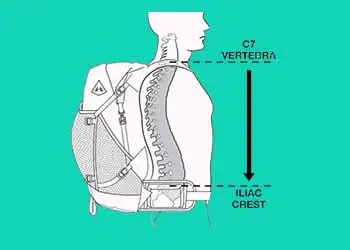
Knowing how to choose a backpacking pack can be a big advantage for you to choose a good backpack. To fit a bag on the back, torso length is an important factor to consider when fitting a backpack as it determines the distance between the shoulder straps and the hip belt. To measure your torso length, you need to locate the C7 vertebra at the base of your neck, which protrudes slightly when you tilt your head forward. Next, locate the top of your hip bones by placing your hands on your hips and feeling for the bony protrusions. Measure the distance between the C7 vertebra and the top of your hip bones using a tape measure, and you’ll have your torso length. It’s essential to choose a backpack with an adjustable back panel to match your torso length to ensure the proper fit, weight distribution, and comfort while carrying the backpack.
Waist Size
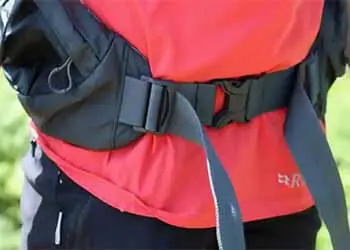
When fitting a backpack, it’s also important to consider your waist size to ensure a comfortable and secure fit. To measure your waist size, use a measuring tape to measure around your waist, where you usually wear your pants or shorts. It’s important to ensure that the measuring tape is snug but not too tight to get an accurate measurement. Many backpacks come with adjustable hip belts, which allow you to customize the fit to match your waist size. A well-fitted hip belt should rest comfortably on your hip bones, with the padding distributing the weight of the backpack evenly. A hip belt that’s too loose can cause the backpack to bounce and sway, while one that’s too tight can cause discomfort and impede your breathing. Therefore, you should know how to choose the best travel backpack with an adjustable hip belt that matches your waist size to ensure a comfortable and secure fit.
Now let’s know how to fit a backpack properly.
How to fit a backpack?
When fitting a backpack, it’s crucial to consider several factors to achieve a comfortable and stable fit. If you know what size backpack should you choose, your backpack could be the best fit. However, here are some steps to follow:
- Measure your torso length: Most backpacks come with an adjustable back panel, but it’s essential to measure your torso length to ensure the proper fit. To measure your torso length, locate the C7 vertebra at the base of your neck and the top of your hip bones, and measure the distance between them using a tape measure.
- Adjust the shoulder straps: Once you have your backpack on, adjust the shoulder straps so that they sit comfortably on your shoulders without digging in. Ensure that the backpack sits snugly against your back.
- Adjust the hip belt: The hip belt should sit comfortably on your hip bones, with the padding distributing the weight of the backpack evenly. Adjust the hip belt for a snug but not too tight fit.
- Customize your chest strap: The chest strap helps to stabilize the backpack and prevent it from bouncing while walking. Adjust it so that it sits comfortably across your chest, and the shoulder straps are snug but not too tight.
- Adjust the load-lifter straps: These straps help to pull the backpack closer to your body, improving stability and comfort. Adjust them so that they form a 45-degree angle with the backpack.
- Adjust the sternum strap: The sternum strap connects the two shoulder straps across the chest, providing additional stability and reducing the load on your shoulders. Adjust it so that it sits comfortably across your chest.
- Check the fit: Once you’ve adjusted all the straps, walk around with the backpack and check the fit. The backpack should feel comfortable and stable, with the weight distributed evenly.
By following these steps, you can ensure that your backpack fits properly and is comfortable to carry, reducing the risk of strain or injury while hiking, traveling, or carrying a heavy load.
What to Look At When Buying a Good Backpack?
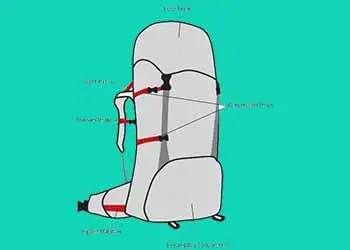
So, do you know how to choose a backpack? When buying a backpack, consider the following factors:
- Size and capacity – Choose a backpack that is appropriate for your needs and can carry all your essentials.
- Comfort and fit – Look for a backpack that fits your body comfortably and has adjustable straps.
- Durability and quality – Consider the material and construction of the backpack to ensure it can withstand regular use.
- Organization and accessibility – Look for a backpack with compartments and pockets to keep your items organized and easily accessible.
- Style and design – Choose a backpack that suits your personal style and preferences.
If you follow these features, you can find the best backpack for school, travel, or hiking. Just be careful about the most important features when you go to buy a backpack for yourself.
Where to buy a good backpack? Well, you can buy it from Amazon or REI.
Final Words
Choosing the right backpack is crucial for a comfortable and safe backpacking experience. A well-fitted backpack can help you carry your gear with ease and prevent injuries. When choosing a backpack, consider the size, capacity, material, and features that are important to you. Make sure to measure your torso length and waist size, and customize the backpack for your body by adjusting the shoulder straps, hip belt, load-lifter straps, and sternum straps. It’s also essential to distribute the weight of the backpack evenly and check the fit by taking a walk around with the backpack on. By following these steps, you can select the perfect backpack and embark on a comfortable and enjoyable backpacking adventure. Hope reading this article on how to choose the right backpack helps you a lot.
Read More Articles:
- Best North Face Backpacks For Travelers
- Can You Wash A North Face Backpack
- Basic Bushcraft Gear
- Best Bushcraft Backpack With Axe Holder
- Best Range Backpacks And Review Guide
- Largest Luggage Size For Check-In
- How To Protect Luggage From Theft
- How To Clean Fabric Luggage
- How Big is a 20 Liter Backpack?
- How Big is a 40 Liter Backpack?
- How Big Is a 30 Liter Backpack?

